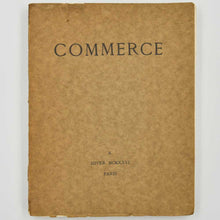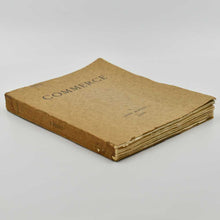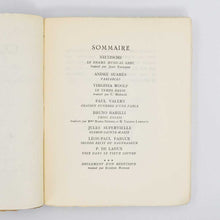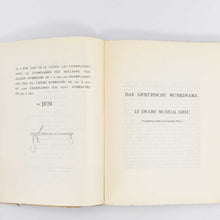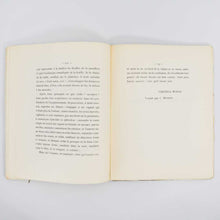
A PRE-PUBLICATION FRAGMENT OF TO THE LIGHTHOUSE
[WOOLF, Virginia]. [MAURON, Charles]. COMMERCE. Paris: Librairie Henri Leclerc. 1926.
Original brown card wrappers lettered in black front panel and spine, bookplate of William Beekman to inside of front cover; untrimmed pages; pp. 200 [2]; repaired tear to upper corner of front wrapper, creasing and minor chipping to spine; very light creasing to a handful of leaves; a very good copy.
First limited edition, number 1020 of 2,500 copies on Alfa Paper from a total print-run of 2,900, 100 of which were printed on Hollande Van Gelder Paper, 300 on Pur Fil Lafuma paper; including the first published excerpt (in French) of Woolf's To the Lighthouse.
“Time Passes”, the central section of Virginia Woolf's novel To the Lighthouse, was completed in draft at the end of May 1926. The author’s diary makes clear that it was a piece of writing that gave her more than usual trouble. Recording the passage of ten years between the two outer sections of the novel (set pre- and post-war), the central presence is the Ramsays' holiday house on the Isle of Skye (where the events of the outer sections takes place), now empty, with the objects inside the house as “minor characters”; all subjected to the passage and erosion effected by time.
A version of the text in French – the author’s first publication in that language – was published in the Winter 1926 issue of Commerce, in a translation by Charles Mauron, friend of Roger Fry and E. M. Forster, who had already translated the latter’s work and would go on to translate Woolf’s Orlando and Flush.
On 19 October 1926, Woolf wrote to Mauron that “The Princesse di Bassiano has asked me to suggest a translator for a chapter from a book of mine which is being published in Commerce [the Princess’s literary journal] in January. Mr. Forster has advised me to ask you if you would do it, as he so much admires your translation of The Passage to India. I have told the Princesse that if you are willing, I should prefer her to ask you, and I hope very much that you will agree, if she writes to you. It is about 7,000 words long”.
“Le Temps Passe” is presented as a free-standing work, more overtly experimental than the later version (published in 1927 as part of the complete novel), and more ethereal, stripped as it is of direct or indirect reference to the novel’s surrounding human traffic; a weakness, for Fry, ameliorated by the rendering into French (a language which naturally smooths down Woolf’s prose).
In his useful introduction to a reprint of Mauron’s translation, together with a recently discovered intermediate English typescript, James M. Haule proposes that “Woolf saw periodical publication as a way to present a version of the entire section in a form that conveyed her original intention: a separate but important statement of belief and unbelief. It had not become the 'corridor' between the two large sections of the novel that she sketched in her notebooks. It had become something more. By publishing this section with the help of Roger Fry and by publishing it in translation, she not only saw it into print, but also accomplished something else. She put it in the hands of a critic she admired and, owing to her severe misgivings about this section, reduced her risk of unfavourable impact from what she feared was a 'hopeless mess' by publishing it in a language other than English”.
Provenance: From the library of William Beekman. Beekman was a serious collector of Woolf's work over many decades. The "William Beekman Collection of Virginia Woolf and Her Circle" is now held at the New York Public Library. Many of the books in Beekman's collection were originally owned, or gifted, by Virginia Woolf and Leonard Woolf.
Kirkpatrick D44. See James M. Haule, "Virginia Woolf and Charles Mauron", Twentieth Century Literature, 29.3 (Autumn, 1983).
#2121905





